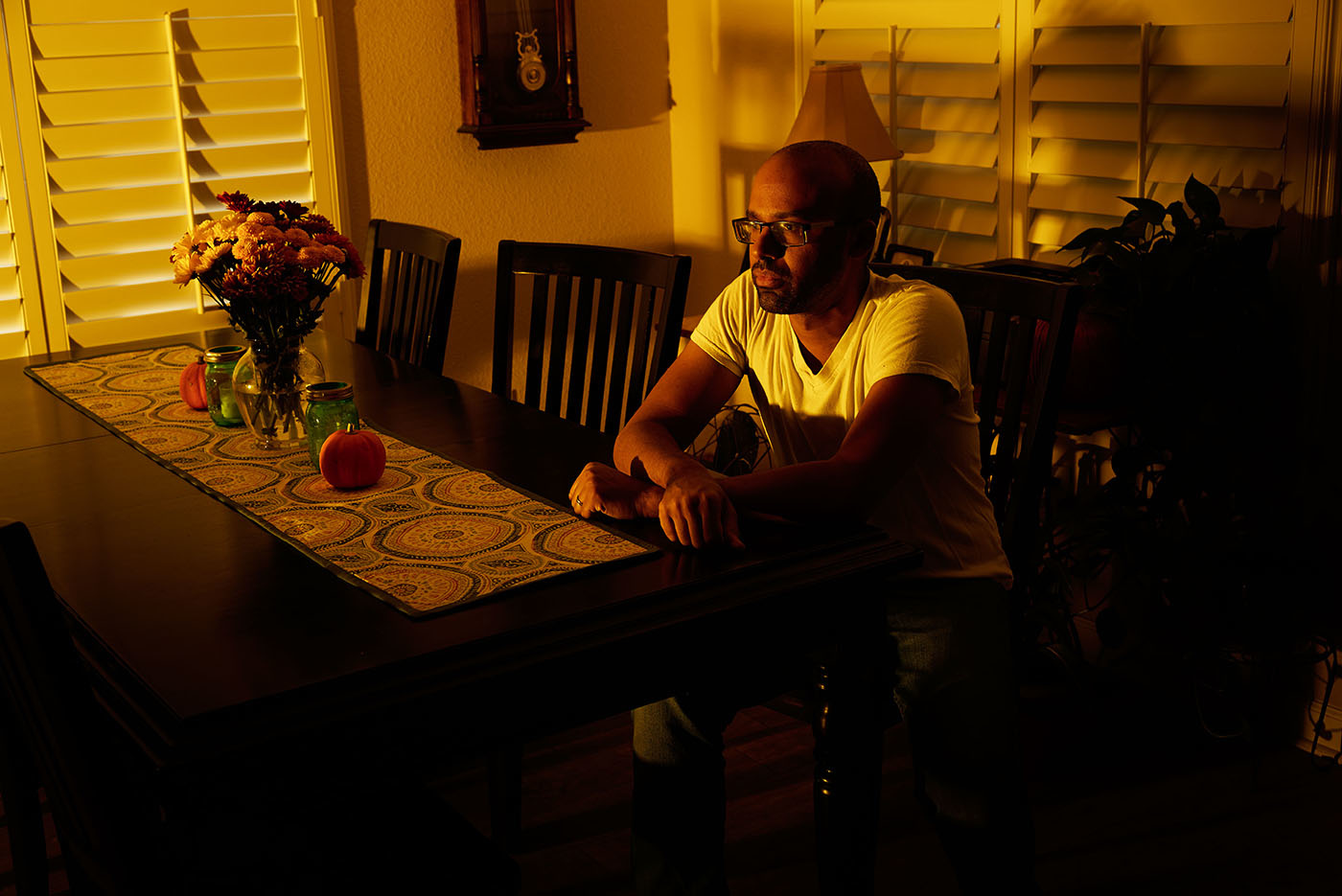We've all done it. We find a location for our subject, place them, set up a light pointing down at 45 degrees, check the light power, and start shooting. When shooting an environmental portrait, there's a lot to worry about. From interacting with your subject to hauling equipment and making sure makeup and wardrobe are on point, it's easy to fall back on our go-to lighting setups. As an exercise, though, let's concentrate on ancillary lighting first and see how it can drive the narrative of our shot.
For this little experiment, I did a quick shot to show what the room looked like with no supplemental lighting. Try to ignore the ever so dashing subject for the moment. Notice that the subject is in shadow, there is bright sunlight streaming through the blinds, and the subject's wife obviously loves to decorate.

An ominous figure in darkness or just an unlit shot? Probably just an unlit shot.
Now, let's go to the obvious choice for lighting first. I would typically walk into the room, grab a big, soft modifier, throw it on my light, and then refine the shot until I got the image I see in my head. The light is flattering and balances the shot without looking too flashy. I could add a fill or reflector to fill in the shadows and be done with it. But does the photo say anything? Does it make the mind wander? Does it tell or support a story? Is it compelling?

Better! But not inspiring. Does the image say anything to the viewer?
Now, let's try a different approach. Let's use some gels and hard light to throw in supplemental light first. These aren't meant to be finished shots, but I want to show an alternate way of building the lighting in your shots by focusing on lights that are coming from off set. Note how they inform the scene? Are they more effective in establishing a mood? Do they make the mind create its own stories? To color the lights, I used a cheap barn door and gel set. Nothing fancy.

First off, let's introduce a hard, blue light down low and camera right. Does this change the mood? Tremendously! I could see this light being a television, emanating light onto our subject, creating a somber, moody atmosphere. From here, you could add a touch of fill to light up the background or perhaps a reflector if the shadows are too deep for your taste. Maybe a light or two outside to even out the scene.

How about this yellow light from another room? Maybe this is a man who came into the room for a midnight snack and left the light on in the other room. Maybe it's an interrogation scene. Maybe there's a window and there are sodium lights outside. How would you add to the scene to flesh it out? Or does the light not appeal but make you think of something else that does?

Here, the red coming from outside hints at taillights from a vehicle to me. Maybe some haze or atmospheric affects to accentuate the mood? Who just left the scene? Where are they going? What just happened and how does it affect your photograph?
Of course, these are very simple lighting choices, but when you're planning your shoots, occasionally taking this outside-in approach can spark a creative fire and inform the scene in a way that maybe you hadn't considered. As an exercise, when lighting your next environmental portrait, throw a light somewhere you ordinarily wouldn't and see what happens! Perhaps your creative juices will flow in a way that defies your normal approach.
Give it a shot and let us know how it goes!







I am thinking of using a powerful light into a 7foot parabolic umbrella OUTSIDE a window, as to simulate the sun creeping into the room, mixing it with partly ambiant light. Ever tried ''faking'' the sun outside ?
Sure! But when you're simulating sunlight it's typically a hard light, not diffuse. Plus you dont have to worry about a large modifier ending up in your shot.
The lead shot of this article simulates direct sunset light
Basically a CTO Gelled strobe outside
https://scontent.xx.fbcdn.net/v/t1.0-9/13315568_10154146253600772_725704...
Here is an example of a photographer in my country, straight CTO outside of gym
Digging the opening photo, anyway we can get a larger link?